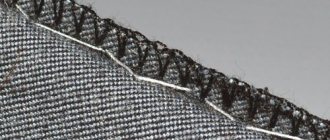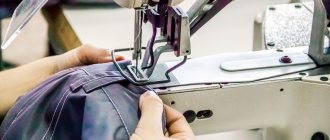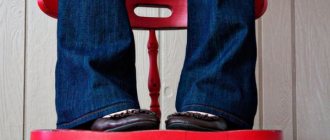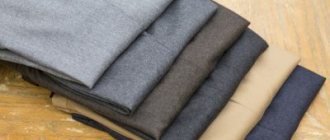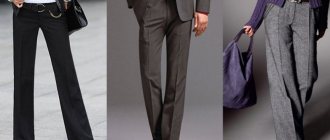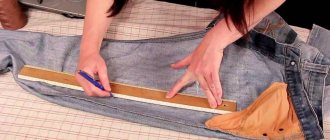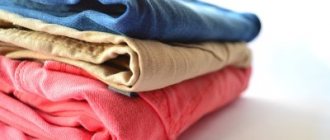The problem of changing pants to a size smaller can arise for various reasons.
Firstly, the new thing may not fit your figure so perfectly. The non-standard figure of girls pushes them to undergo this operation in the pursuit of beauty. For example, height, fatness or thinness. Most often the length is shortened. Secondly, the product may stretch if washed incorrectly. Most often this is non-compliance with the temperature or spin conditions. The length or width of the trouser legs is altered.
Thirdly, my favorite thing became too big after losing weight. You will have to change the width of the trouser legs, at the waist, at the hips. Fourthly, the purchase was made under the influence of a moment of weakness. I liked the model, but didn't have the right size. But upon closer examination, it was decided to sew in or alter the product.
Fifthly, following fashion trends is not always affordable for fashionistas. And you have to resort to tricks. One such change is altering existing trousers. Or just change the model of your pants. Sixth, the trousers can fit well, except in some places. For example, flares, in the hip area.
Seventhly, abrasions or defects of the product could be discovered. Such services can be expensive in a studio. Therefore, it is better to stitch at home, provided you have minimal sewing knowledge.
Causes
There may be several reasons why you have to change the size of an item:
- Firstly, even new trousers may not fit your figure as perfectly as you would like. The problem in this case is complicated by non-standard parameters and proportions.
- Secondly, if washed incorrectly, the fabric can become deformed, and you already get a model that is, as they say, “to grow.” Most often this happens when the temperature or spin mode is not observed. Usually the width and length of the model are subject to correction.
- Thirdly, you may simply lose weight, and your favorite item becomes baggy and uncomfortable. As a rule, in this situation you have to change the width of the trouser legs, as well as reduce the size of the item at the hips and waist.
- Fourthly, the item was purchased obviously not in your size, simply because there was no other size. And now, in order to wear the item you like, you need to change the size yourself.
- Fifthly, the reason for the “reconstruction” is changing fashion: today wide trousers are in trend, and tomorrow – tight ones. In order not to purchase a new item for each season, it makes sense to adjust existing models.
- Sixthly, and this is perhaps one of the most common options, the item fits well, but not in all places. For example, the waist suits you, but the hips are too wide.
- Seventhly, the reason for alterations is the discovery of defects in the fabric or abrasions. In this case, having minimal seamstress skills, you can easily “hide” the defect.
There are many reasons why you may need to sew in your trousers.
Prints and palette
The colors of tapered trousers vary depending on seasonality, style and purpose. The trousers of the basic palette do not give up their positions, which are characterized by excellent compatibility and allow you to wear the same trousers to different events. Bright and printed fabrics are good in a summer wardrobe. And this season's favorite are pants in powdery tones.
Blue
Blue trousers are suitable for the office and for every day: from the color of the night sky to azure. The darker the shade of the trousers, the more likely they are to be included in a business outfit. Stretch jeans in natural tones will also be in fashion, and it is unlikely that they will be ousted from the fashion catwalk.
“Cigarettes” or tapered trousers in dark blue tones harmonize with milky and white blouses, blouses and striped long sleeves reminiscent of vests. Such combinations are so loved by fashionistas that now they can be found not only in everyday, but also office looks.
Black
Black skinny trousers have no competitors. For fashionistas with a larger body and women of short stature, black trousers with arrows are a good way to hide figure flaws. But black is considered a gloomy color, and therefore it needs to be properly diluted. A combination of a white or emerald blouse will refresh the ensemble.
Pants require a companion in rich colors or clothes with expressive prints. Blouses with a leopard print, Khokhloma pattern or black and white polka dots can complement tapered trousers.
Gray
Smoky-gray shades are also held in high esteem. Rich and deep anthracite color does not look as dark as black. It perfectly slims and makes the image strict, but does not turn the outfit into a mourning one. Gray classic suit trousers are worth purchasing for women who spend more time at work than at home. It is enough to change a blouse or jacket - and now we have a new and completely different image from the previous one.
Gray chinos are a trend in recent seasons. This is a good purchase for those who prefer comfortable looks for the office and enjoy wearing trousers every day.
Beige
The nude palette rules the roost. Various shades of beige appear in a variety of outfits. Today you can choose satin trousers for a holiday and models made of thick suiting fabric for work, knitted trousers for every day and nude skinny pants for provocative ensembles.
With patterns
Narrow cuts and catchy patterns are compatible, but such products should only be worn with the right combination. Not every figure is suitable for colorful patterns, although vertical stripes or checks are considered utilitarian solutions.
Find out what prints are in fashion:
- camouflage - suitable exclusively for youth wardrobes. They draw attention to the legs, so any imperfections will be immediately noticeable to others. The pattern has an optical effect and can visually add volume to a lean figure;
- animalistic – daring fashionistas with an enviable figure will dare to try on trousers with a predatory pattern. Leggings with a leopard print or tiger-inspired “cigarettes” can become the highlight of an image if paired correctly;
- floral – bright flowers look good on a white or black background. For a summer wardrobe, such slims will be a godsend.
In stores you will find trousers with polka dot patterns, zigzags in a rich palette, stains and with the effect of faded denim. If your figure and age allow it, then you can try all these solutions.
Materials and tools
You will need a gentleman's set of tailor's tools: needles, pins, tailor's yardstick, strong thread, scissors and soap or chalk.
Prepare in advance the tools you may need. A sewing machine is not always required. But minimal sewing skills will not be superfluous. It has been noticed that a professional spends 30-40 minutes on correcting products, while a beginner needs at least 2-3 hours.
A sewing machine will not be needed in all cases. And remember, trousers are considered a complex tailoring product, which means that sewing them will require a lot of effort and patience.
Women's trousers are considered a rather complex sewing product.
What should you pay attention to?
When altering pants, it is important to remember that there are generally accepted rules, following which you can achieve an almost perfect result. For example, you should understand that not all trouser styles can be altered . For basting, it is better to use white threads; they do not contain dye, so you do not have to wash the updated product later. The situation is similar with chalk for marks; it is better to use a regular bar of soap, then the lines can be easily removed by steaming. And at the end of the work, you need to carefully steam and iron the product, this is the only way it will look perfect.
Knitting a pullover for a boy with knitting needles
What shirt to wear with blue trousers
We sew by hand
First of all, you need to decide in which direction the product will be corrected. They are sutured either along the length (shortened), or along the width of the trouser legs, or at the hips or waist.
If you need to reduce your trousers not at the waist, you can do without a pattern. In some cases, suturing can be done without a pattern. These are small adjustments, for example, changing the length, creating small darts, narrowing the trouser legs towards the bottom. And in other situations you cannot do without a pattern, usually this concerns changes in the waist area.
To solve such a problem, a pattern is often required.
Product preparation
Don't rush to pick up a needle and thread. To make the process as convenient as possible and the result worthy, the item needs to be prepared.
- The item needs to be washed. Natural fabrics such as cotton, wool, linen shrink and may well fit to the size you need.
- Ironing the thing. This is necessary to avoid mistakes and irregularities.
- The trousers are tried on with pins on the fabric.
Excess fabric is marked with pins. As you prepare, always have chalk or soap ready, as well as a sewing ruler, pins, and scissors.
Keep all the necessary tools at hand.
Do not make marks on the fabric with a pen or pencil. There will be traces left that are difficult to get rid of.
Ways to make jeans smaller without stitching
Denim fabric tends to shrink with each wash and then stretch again when worn. Therefore, the easiest way to make your jeans fit smaller is to wash and dry your jeans more often. There is no need to rush to sew in new trousers if they are a little big. After a few washes, they may shrink without using other methods.
Even very high-quality jeans can stretch when worn for a long time. Therefore, it is often recommended to buy them 1-2 sizes smaller. But this is very risky because they may be made from a type of fabric that does not stretch much.
It is better to immediately choose comfortable jeans, and if they have increased in size, then wash them in the machine at high temperature and then dry them in a hot dryer. They will definitely decrease.
Important! After washing, you should not iron jeans if they are still damp (this will cause them to stretch again) - only when they are completely dry and with a slightly dampened iron.
Proper drying allows the shrinkage to be consolidated and preserved. If there is no special automatic dryer, then the following methods are used:
- when it's heating season, hang jeans on the radiator;
- hang your trousers on a rope and place an electric heater or other heat source nearby;
- Place a moisture-absorbing material on the top and bottom of your wet jeans on the table and change it periodically when it gets wet.
Advice! The shrinkage method reduces the size of the trousers not only in width, but also in length. This must be taken into account and first carry out thermal shrinkage, then only roll it up to the required length (if required).
Cooking method
This is an aggressive method, but it allows you to reduce jeans by several sizes at once. The main drawback is that the jeans will fade and look like the once fashionable “varenki”.
How to “weld” jeans:
- Select a container of sufficient size.
- Pour water into it and add washing powder to form a concentrated solution.
- Cook the jeans over medium heat for about half an hour.
- Remove the hot item with tongs and rinse.
How to reduce only a certain area
If you want to fit only part of the trousers, then the following method is used:
- Fill a spray bottle with warm water and add fabric softener.
- Spray the liquid only on the areas of the trousers that need shrinking.
- Dry the item in a special dryer or other suitable method. The wet areas will shrink, and the dry areas will remain the same size.
It is not recommended to shrink trousers made of thin “summer” jeans, because this is a regular denim-dyed cotton, which has lower strength. Washing at high temperatures causes it to wear out quickly.
How to make your waist smaller with an elastic band
If the belt is not too large at the waist, then the problem is solved with the help of a wide elastic band.
- Underside the belt at the back of the trousers.
- Cut the elastic to the desired length, pin it to the belt and try it on. If necessary, reduce or increase its length by adjusting with pins.
- When a suitable option is found, sew the elastic band to the belt.
- Then sew on the belt. As a result, only a slight ruffle will be visible in the back, and the jeans will fit perfectly at the waist.
There were flared trousers, but now they are straight
A flare is an extension of trousers that can start from the waist, hip or knee.
It is possible to convert flares into straight trousers. How to remove this extension?
- Try on the item and carefully examine yourself in the mirror. Evaluate the fit of the item from different angles.
- Sewing pins mark the excess that will need to be removed. We stick the pins with the point down so as not to get hurt.
- You can mark on two legs at once, or you can only mark on one, and then use a ruler to transfer the measurements to the other. Ultimately, both pant legs should be the same.
- We remove the trousers carefully so that the needles do not fall out.
- We lay out the product on a large table, aligning the edges.
- We perform all actions first on one trouser leg, and then on the other.
- We draw a line marked with pins with chalk, then remove the pins and carefully straighten the pant leg.
- Mark the second line for the side seam (approximately 1-2 cm).
- Along the first line we baste and try on the item. We evaluate the convenience, make sure that the seam is straight, and check for errors in the measurements.
- If necessary, we make adjustments and try it on again.
- We remove excess fabric, iron it, finish the edge, and sew it on a sewing machine.
The lower part is neatly tapered.
Change of style
Classic jeans and trousers are the main elements of any woman's wardrobe. There are many styles on the market, but not every fashionista allows herself to change things too often. With a little sewing skill you can change the cut of your pants.
Straight from flared
To change flared trousers into straight ones, you need to try on the product, assess the scale of future work, examine the fit from different angles, and mark the excess fabric (from the inside out, using pins). Then you need to carefully remove the item, align the edges and use soap to mark the places marked with pins. Having straightened the trouser leg, you need to draw two straight lines until it meets the side seam, and sweep it with threads. Afterwards, you should try on the resulting product, check for measurement errors, comfort (make adjustments if necessary). If necessary, it is recommended to remove excess with scissors, then iron the item and turn it inside out. At the last stage, you need to align, process the ends using a machine, and sew the product.
Lay the pants out on a flat surface
Draw a new seam line
Sew along the drawn line
Cut off excess
Finish the edge of the seam with an overlocker
Hem the bottom of the pants
Tapered to the bottom
Bell-bottoms have been out of fashion for a long time, and girls have no choice but to tape off trousers of this style. This can be done even with old things that belonged to mom. To suture, narrowing from below at home, you need:
- open the bottom edge (hem), iron the item, try it on;
- use pins to mark how much needs to be removed (if there is a slight narrowing at the bottom, adjust only on one side);
- Carefully remove the product and spread it on a flat surface;
- remove the pins and draw soap on the intended places;
- baste with thread along the first line, try on again;
- cut off excess fabric, go along the edges of the trouser leg using an overlocker and sew on a machine;
- Use adjustments on both sides if there is a significant change in the style of the trousers.
You can narrow your jeans to the bottom both at home and in the studio. Bell-bottomed trousers are something that you don’t have to throw away just because they’re out of fashion. You can alter them a little yourself and wear them again. Such trousers can easily be converted into skinny ones, which are now at the peak of popularity.
How to tape your trousers to the bottom
First, we rip out the hem of the trousers and iron the product. We try it on and note how much the trouser leg needs to be narrowed. If the adjustment is small, then we sew it on one side, and if we need to significantly reduce the width, then we sew it on both sides. With a small adjustment, it is recommended to evaluate which side - internal or external - is better to sutured. The peculiarity of the seam and the presence of decor are taken into account.
A common reason for sewing up trousers is the desire to narrow them at the bottom. Mark the excess fabric on the fabric. You should be especially careful with stretch fabrics. If you suture by pulling the fabric, the result will be crooked. If the fabric does not stretch, then you can sew it as wide as possible to such a width that the leg fits comfortably into the pant leg.
Algorithm of actions
- We carefully spread the pants on the table. At the same time, the table must be large enough for the item to fit completely.
- We align, draw a line along the pins, then draw another one for the seam.
- We mark along the first line.
- We try them on and evaluate how beautifully and comfortably the trousers fit.
- If something doesn’t suit you, we adjust it and try it on again.
- Cut off the excess fabric and trim the edge.
- Then we sew a line on a sewing machine.
If everything is done correctly, the result will please you. If you need to narrow it a lot, then all the above actions are carried out both on the outside and on the inside of the trouser leg.
Do they need to be redrawn and how?
If you need to reduce your pants by 3 or more sizes, you will have to cut them again.
Before you start, you should soberly assess your strengths so as not to spoil the thing. If you have the slightest doubt, you shouldn’t take risks; it’s better to trust the professionals and take your panties to a tailor. A reduction of 3 sizes is carried out at the waist, hips and groin. The first step is to carefully rip the product open using a ripper, nail scissors or a blade. First, the lining of the belt in the area of the seat seam, the seat seam itself and the crotch seams are ripped off to the level of the hips. Remove threads from edges and iron. Mark points:
- the ends of the belt, in accordance with the measurement of waist circumference;
- rear width along the step line;
- width of the back along the hip line;
- connect the resulting points with one line using chalk. It will duplicate the cut line. Place basting stitches along the chalk line. Try it on. If it fits well, then stitch along all the edges. Iron well;
- straighten the lining of the belt and hem it to the edge in the area of the seat seam;
- iron everything.
When a product needs to be sewn in 4 or more sizes, the trousers are completely recut . That is, they rip out all the seams completely, get rid of the threads, iron them, re-cut them, cut off the excess and grind them down in the same way as during the initial sewing.
Sew on the sides
If the item is too big for you in the hip area, then it should be sutured along the outer seam:
- We turn the product inside out, try it on, if possible, actively - squat, walk.
- We mark with pins the places where the volume needs to be reduced. We distribute everything equally so that there is no curvature as a result.
- Draw a straight line with chalk and sweep it by hand.
- We turn the product inside out and try it on (again, actively).
- We rip out the factory stitching and sew along the entire length of the trouser leg along the intended new seam so that there are no distortions.
- Cut off the excess fabric and trim the edges.
- Sew on the belt and bend the edges of the trouser leg.
- We do the same with the second leg.
You can sew the sides of the trousers along the outer and inner seams. In some cases, for example, if there is decor, it is not advisable to touch the external seams. Then the item is sutured along the inner seam. They also work if you need to adjust the waistline of your trousers.
- We turn the trousers inside out, try them on and mark the excess.
- We take the thing off and lay it out on the table.
- We tear off the belt and cut it in half at the back.
- Apply a new seam using thread and needle to both parts of the item.
- We trim off the excess, process the edges, stitch.
- The last step is to sew on the belt.
If you need to significantly reduce the size of your trousers, for example, by two sizes or more, then you will have to stitch along both the outer and inner seams. The procedure is the same as in the case of decreasing one seam at a time, the indicators are simply divided by two.
Reducing the width
Sometimes it is necessary to sew the product in width - reduce the volume, narrow it or even it out. This can be done by adjusting them only on the sides or on both sides - external and internal.
Sew on the sides
One of the easiest ways: for straight legs, and cases when you don’t need to remove too much fabric. Wide leg trousers are easy to sew in.
- Open the waistband in sections 4 cm on each side of the seam on both sides.
- Unravel the side seams in areas where you need to reduce the size of the trousers.
- Sew a new stitch by hand using thread or pins. Try it on and check the fit.
- Mark a new line with chalk and remove the pins. Then step back 1 cm inward from the marked lines and draw an allowance. Trim off excess fabric.
- Stitch the item, try it on again and, if everything is in order, work on the seam allowances.
- Sew on the belt.
In addition to a simple connection, the pants can be processed in a more complex way: Moscow seam, hemmed, with edging. If performing the same processing method is beyond your capabilities, then you can either choose an easier method or contact a studio.
Sew the sides of the trousers
If you need to make major adjustments, it is better to sew the pants on both sides - along the inside seam and along the side seam. This method is often used to sew men's trousers. If you want to narrow your pant legs, this method is best.
- Spread the item on both sides. Also unravel the step cut in the groin area.
- Use chalk to mark new seam lines.
- Put the product together by hand and try it on.
- Sew the sides first, then the inside.
- Place one pant leg inside the other and connect the step cut, falling exactly into the stitch.
The main thing when remaking products is fitting. Carry it out at every stage so that the item fits like a glove. It is advisable if someone helps you, since it is quite difficult to assess the fit on your own.
Sewing trousers in a belt
There are several ways to make your trousers smaller at the waist.
Pants that are too big at the waist are one of the most common problems.
By darts
First you need to estimate how much the item will be sewn in. Excess volume will be removed due to darts. At the same time, you can either increase existing ones or make new ones.
Before you start trying on, the trousers must be ironed. Pants need to be carefully ironed and tried on. Then comes the fabric that will be removed using darts. The edges of the darts can touch the side seams, but this is not the best option. Skewing or unsightly folds may appear.
Before suturing, the trouser waistband is ripped open. Then the harness and belt are ripped out, a basting is made and excess fabric is removed. Darts are sewn on a machine. And the belt itself is cut on the sides and the excess length is removed. After this, the product and the belt are ground off. The belt is carefully sewn along the lines to the product, and then the harness is attached.
Reduced volume due to back seam
This is one of the most common ways to reduce your waist by several sizes. The trousers are tried on and it is determined how much reduction should be done.
Thanks to this method, you can reduce the waist of your trousers by several sizes. After this, the belt loops (belt holders) and the belt are removed. The belt is cut into two parts.
The belt is ripped open and divided into two parts. The stitch on the middle seam is ripped out, and the seam is sutured to the marked values. The belt is reduced and processed. Then a stitch is sewn along the waistband using a sewing machine. The belt is sewn to the trousers, and the final stage is the restoration of the belt loop.
The seam according to the basting must be sewn on a machine.
Complete alteration of trousers
This is the most labor-intensive option, but, as a rule, it is thanks to it that the best “fit” of the product is achieved. To implement this project, the belt is torn off approximately 10 cm in each direction from the seam, and the belt loops are removed.
To completely re-stitch, you will need to rip out all the main seams. Then the crotch seam is ripped out by 9-10 centimeters. The middle seam also rips open. To prevent the product from warping, the opened seams are secured with pins. At the waist, retreat 2 centimeters in both directions and draw a line for the future seam. The result should be a triangle.
The stitches are laid in the following order: first the back seam, then the step seam, and at the very end the belt and belt loops are sewn on.
Reducing the waist
There are several ways to sew trousers in the waistband: insert darts or cut off the excess with scissors along the side seams or along the step cut. The first method is good for light and medium fabrics, and it is better to adjust jeans at the seams. Reducing the sides is suitable if you are going to alter a man's trousers. There are practically no darts made on them.
Correcting the middle seam
Reducing the step cut (located at the back, in the center) is the best solution if your figure has a large difference between the waist and buttocks. The operation is simple; the only thing that can complicate things is the belt loops, which will need to be moved.
- Open the waistband stitching by 10-12 cm and step the cut to the hips or below. Open the belt loops if there are any.
- Mark a new center seam line with chalk, adding an inch on each side for the seam allowance.
- Place a line. Try it on and make changes if necessary.
- Cut the belt in half and reduce it to the new size.
- Move the belt loops to a new distance, and then sew them in the same way as the rest.
Don't cut the fabric without making sure you leave an allowance. It is better to first lay a new line, and then cut off the excess, so that there is still an opportunity to fix everything.
We correct only on the sides
The operation is similar to the method described above with the difference that now we are making adjustments only on the sides.
- Unfasten the waistband at the sides and spread the product out to the sides by 20-23 cm.
- Mark new lines, hand baste and try on.
- Sew stitches on a sewing machine.
- Reattach the waistband the same way it was finished.
Reduce with darts
You can reduce the waistband of your pants by adding darts. They are placed on both sides, at a distance of approximately 10 centimeters from the center. Darts are useful if the fastening is located on the side. This method is often used to sew in women's trousers.
- Decide where you will place the darts. Undo the belt in all these areas: you will have to rip it off almost completely, leaving only the clasp intact.
- Try it on and fold in excess fabric and pin it.
- Baste by hand and then stitch by machine.
- Iron the darts, placing them mirror-like from the center line.
- Cut the belt, remove the excess length and stitch again.
- Sew it to the waist.
How to shorten pants
To avoid disappointment with the result, it is very important to take the fitting seriously before cutting off the excess length. Come and sit down. And it’s better to do this in front of a mirror so that you understand how cropped trousers will look from the outside. It is ideal if another person does the bending, and not you yourself.
You need to measure the excess length very carefully and carefully. If the trousers are women's, and their owner wears shoes with heels, this must also be taken into account. In addition, the length directly depends on the model of trousers: wide ones should cover the heel, and narrow ones should be just above the heel.
We turn the trousers inside out and put them on the table. We draw a straight line along the marked marks. And one more line - taking into account the hem. On women's trousers, 1-2 cm is left for the hem, and on men's trousers, 4-5 cm.
We bend and baste the trouser legs. We try it on again, and again don’t forget to sit down, walk, and put on high-heeled shoes. If the result is unsatisfactory in some way, we correct it. If everything is in order, then lay out the product on the table, cut off the excess fabric, process the edges and sew it on the machine. By the way, if the excess fabric is small, then you may decide to fold it into the hem without resorting to scissors.
Some people prefer to use double-sided sewing tape for hems. This option is less labor-intensive, but after washing you may have to glue a new tape.
The new length is fixed either with a special tape or with a seam. In order to prevent abrasion of the edges of the trouser legs, it is recommended to sew a braid to the inside. It is chosen to match the product and thanks to its use, the trousers retain their decent appearance longer.
How to cut your own jeans to fit women's and men's shorts
Shorts are made from jeans that fit well on the hips and buttocks. Choose length:
- classic – 8-12 cm above the knee;
- up to the knees;
- at calf level (capri pants).
Slender girls can afford short shorts that barely cover their buttocks or even partially show them off. For classic shorts, both loose and skinny jeans are suitable, but not stretch ones - they don’t hold their shape well.
The pants need to be prepared: washed (so that possible shrinkage occurs before processing) and ironed.
Jeans are cut like this:
- They put it on and, standing in front of the mirror, mark the length. Simply select a point on one of the legs and mark it with a fastened pin.
- The jeans are laid out on a flat surface and a straight line is first drawn from the marked point, and then raised slightly from the sides, so that the middle part is slightly lower. After this, mark the allowance line and cut off the excess length along it.
- Turn it inside out and chop off the side joints. Transfer the cutting line to the second leg. Then they check it by taking control measurements from the top point of the waistband, the center of the legs and the top point of the crotch seam connecting the front and back parts on the inside of the pants.
Most often, the shorts are simply cut off and the hem is tousled, turning it into a fringe. But you can leave an allowance for the hem at the bottom. And stretch jeans must be hemmed, because... The fabric contains elastic bands and plastic threads, which look ugly. Required allowances:
- for fringe – 2 cm;
- for hem – 4-5 cm.
For men, shorts are not made short; they choose a length up to the knees, as well as 7-10 cm higher or lower. The length is measured and the jeans are cut as described above. Straight-leg jeans are more suitable for alterations. If they have the same look as dress pants at the top, they can be turned into bermuda shorts with cuffs. To do this, leave an allowance of 7-8 cm.
How to sew sweatpants
Before you begin, please consider the following points:
- The fabric from which the sweatpants are made (most often it is knitwear; working with it requires compliance with certain rules);
- Edge processing (with elastic, with ties, free edge);
- Sports trousers model: oriental version, tight or straight. If the model is tight, then, as a rule, you have to completely alter it. If the trousers are sewn according to the oriental type, then you need to work with the side and crotch seams.
The trousers can be too wide in the elastic waist, the width of the legs, and the length. If you need to adjust the landing height, you will have to work with the middle seam. If the model is large in the hips, then the “extra” width is removed, dividing it evenly between the internal and external seams.
The procedure is as follows: first we try on the product, mark the excess and remove it. Turn it inside out. Lay out the trousers on the table so that there are no folds or bends in the fabric. Draw a line along the marks and leave an allowance for finishing the edge. We baste and try on. Then we rip out the belt and the bottom edge of the trousers. After this, we rip out the edges of the side seams, as well as the step and seat seams.
You can also try sewing women's sweatpants yourself. All seams are ripped out only if your trousers are a tight-fitting model. To correct loose-fitting sweatpants, it is often enough to rip out only the side seams. After this, we machine stitch and process the edges. The excess material on the waistband is trimmed, then the edge is processed and the elastic is sewn on.
When is it worth redesigning the model?
Every girl has at least once bought trousers that no longer suit her. This happens for several reasons. The first of which is rapidly changing fashion. Yesterday it was still at the peak of popularity, and today fashion designers are dictating new conditions. Therefore, once-favorite trousers no longer fit. The second option is a sharp change in the volume of the figure. No matter how funny it may sound, many people dream of losing weight, and there are those who want to gain weight. Because of this, a large number of women no longer look graceful in their pants. In order not to throw away once-loved clothes, they can be completely restored and given a second chance. There are several possible reasons for making this decision:
- violation of internal and external seams. When changing them becomes problematic. It is easier to simply restore the product completely;
- possible change in a woman's tastes. She once liked this model, but later, due to age, changes in taste and physical characteristics, it ceased to be interesting to her;
- the ability to insulate them. Or, on the contrary, change them to a summer version. To change the trousers to the autumn-winter type, you need to purchase additional lining fabric. It needs to be approximately the same thickness as the main one. Then you need to measure the required length and stitch along the edges. If, on the contrary, you need to change the trousers to summer ones, then you need to remove the lining if there is one. Then carefully trim the edges of the seams.
It is worth remembering the main rule that not every model is suitable for the re-cutting process. There are some options that cannot be changed or sutured, as this can significantly distort the shape and appearance of the product. Then it will be quite difficult to change anything, even with the help of a specialist. And sometimes it’s even unrealistic. Of course, completely redesigning your pants and wearing them with pleasure is better than just throwing them away and spending money on new ones.
How to clean a down jacket at home
Beaver fur coat: what kind of fur is this?
How to make skinny jeans
Skinny jeans have gained universal popularity relatively recently. But today, this trouser model is a must-have in the wardrobe of any self-respecting fashionista. Skinny pants fit tightly around slender female legs. But let us immediately note that this model cannot be called universal, because they will not make every figure more attractive. If you are a happy owner of curvy figures, then skinny, alas, is not your story at all.
You can make these women's skinny jeans yourself from the jeans you have at home.
It turns out that you don't have to buy new skinny jeans to be on trend. If you have denim trousers made of elastic fabric, then you can easily make a fashionable wardrobe item yourself.
To do this, the bottom of the denim trousers is ripped off; it should be hemmed last, after the final fitting and often after additional shortening. The jeans are laid out on the table in such a way that there are no irregularities or folds. A common mistake is to sutured only where there is no finishing stitch.
Professionals recommend making 2 control points along the entire length of the trouser leg. In particular, you should never miss the ankle and the middle part of the leg between the ankle and knee. In these places it is better to add 2-3 centimeters for more comfortable wearing.
After this, it is recommended to determine the highest point from which the narrowing will begin and connect all three points in a straight line. No more than 1.5 cm is left as an increase, and the rest of the excess tissue is cut off. After this, they grind along the intended lines, and process the allowances by folding them together and ironing them towards the back halves.
The factory seam for denim products is backstitching. It is almost impossible to repeat it at home, especially if there is no special professional equipment. Therefore, in order for the item to look decent, you need to undo the vertical and finishing stitches completely. The contrast thread, which is common for all denim products without exception, can be omitted.
And in order for the stitching to resemble the factory one as much as possible, to decorate the outer seams, choose a thick needle and use a thread folded in half. Of course, it is important to choose the right thread color.
When sewing several layers of fabric (for example, side seams with a hem), take your time, turn the sewing machine wheel by hand, and carefully pull the fabric away from you.
Now you know how to taper denim pants to get the skinny pants that are fashionable today.
Experts say that absolutely any thing can be sewn in, however, not every model can be handled by a beginner. Usually, in order to avoid disappointment in the result, the correction is done in a comprehensive manner, and then the risk of spoiling the item is very high. Therefore, if you doubt your own abilities, seek help from professionals.
Is it possible to reduce the size
If you reduce by more than two sizes, the item will have to be altered again, so it is better not to do this at home. It is possible to sew in trousers a size smaller, but to do this you will have to adjust them along the entire length and at the waist. To do this, they will have to be almost completely ripped apart. This type of work is quite labor-intensive and requires high sewing skills.
- To do this, completely unravel the product. If no changes are made to the fastener area, then it does not need to be ripped open.
- If you have a pattern, use chalk to trace it onto the old pieces. If there is no pattern, then you can reduce the trousers along the main points and draw new lines on the fabric.
- Trim off excess fabric, leaving allowances.
- Sew the item along the new outline and finish the seams.
- Refold the bottom and stitch the waistband.
Jeans is a material that is made from thick cotton. After an unsuccessful wash, it may change in...
If you are undertaking such an operation for the first time and are not sure of the result, then perhaps you should contact a studio. They'll definitely be able to sew your trousers in properly. Professional tailors will do the job carefully and ensure a fit - but in this case there will be no savings.



